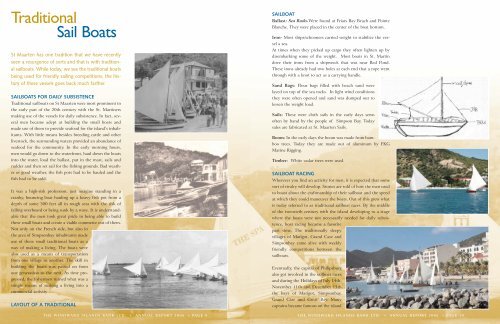Clem Labega Square Philipsburg, St. Maarten, Netherlands Antilles ...
Clem Labega Square Philipsburg, St. Maarten, Netherlands Antilles ...
Clem Labega Square Philipsburg, St. Maarten, Netherlands Antilles ...
Create successful ePaper yourself
Turn your PDF publications into a flip-book with our unique Google optimized e-Paper software.
Traditional<br />
Sail Boats<br />
<strong>St</strong> <strong>Maarten</strong> has one tradition that we have recently<br />
seen a resurgence of sorts and that is with traditional<br />
sailboats. While today, we see the traditional boats<br />
being used for friendly sailing competitions, the history<br />
of these vessels goes back much farther.<br />
SAILBOATS FOR DAILY SUBSISTENCE<br />
Traditional sailboats on <strong>St</strong> <strong>Maarten</strong> were most prominent in<br />
the early part of the 20th century with the <strong>St</strong>. Martiners<br />
making use of the vessels for daily subsistence. In fact, several<br />
men became adept at building the small boats and<br />
made use of them to provide seafood for the island’s inhabitants.<br />
With little means besides breeding cattle and other<br />
livestock, the surrounding waters provided an abundance of<br />
seafood for the community. In the early morning hours,<br />
men would go down to the waterfront, haul down the boats<br />
into the water, load the ballast, put in the mast, sails and<br />
rudder and then set sail for the fishing grounds. Bad weather<br />
or good weather, the fish pots had to be hauled and the<br />
fish had to be sold.<br />
It was a high-risk profession; just imagine standing in a<br />
cranky, bouncing boat hauling up a heavy fish pot from a<br />
depth of some 300 feet all in rough seas with the risk of<br />
falling overboard or being sunk by a wave. It is understandable<br />
that the men took great pride in being able to build<br />
these small boats and create a viable commerce out of them.<br />
Not only on the French side, but also in<br />
the area of Simpsonbay inhabitants made<br />
use of these small traditional boats as a<br />
way of making a living. The boats were<br />
also used as a means of transportation<br />
from one village to another. The skill in<br />
building the boats was passed on from<br />
one generation to the next. As time progressed,<br />
the fishermen turned what was a<br />
simple means of making a living into a<br />
commercial activity .<br />
LAYOUT OF A TRADITIONAL<br />
THE WINDWARD ISLANDS BANK LTD. • ANNUAL REPORT 2006 • PAGE 9<br />
SAILBOAT<br />
Ballast: Sea Rocks-Were found at Friars Bay Beach and Pointe<br />
Blanche. They were placed in the center of the boat bottom.<br />
Iron- Most ships/schooners carried weight to stabilize the vessel<br />
a sea.<br />
At times when they picked up cargo they often lighten up by<br />
disembarking some of the weight. Most boats in <strong>St</strong>. Martin<br />
dove their irons from a shipwreck that was near Red Pond.<br />
These irons already had two holes at each end that a rope went<br />
through with a knot to act as a carrying handle.<br />
Sand Bags: Flour bags filled with beach sand were<br />
layed on top of the sea rocks. In light wind conditions<br />
they were often opened and sand was dumped out to<br />
lessen the weight load.<br />
Sails: These were cloth sails in the early days sewn<br />
often by hand by the people of Simpson Bay. Today<br />
sales are fabricated at <strong>St</strong>. <strong>Maarten</strong> Sails.<br />
Boom: In the early days the boom was made from bamboo<br />
trees. Today they are made out of aluminum by FKG<br />
Marine Rigging.<br />
Timber: White cedar trees were used.<br />
SAILBOAT RACING<br />
Wherever you find an activity for men, it is expected that some<br />
sort of rivalry will develop. <strong>St</strong>ories are told of how the men used<br />
to boast about the craftmanship of their sailboat and the speed<br />
at which they could maneuver the boats. Out of this grew what<br />
is today referred to as traditional sailboat races. By the middle<br />
of the twentieth century with the island developing to a stage<br />
where the boats were not necessarily needed for daily subsistence,<br />
boat racing became a favorite<br />
past time. The traditionally sleepy<br />
villages of Marigot, Grand Case and<br />
Simpsonbay came alive with weekly<br />
friendly competitions between the<br />
sailboats.<br />
Eventually, the capital of <strong>Philipsburg</strong><br />
also got involved in the sailboat races<br />
and during the Holidays of July 14th,<br />
November 11th and December 15th<br />
the bays of Marigot, Simpsonbay,<br />
Grand Case and Great Bay. Many<br />
captains became famous on the island<br />
THE WINDWARD ISLANDS BANK LTD. • ANNUAL REPORT 2006 • PAGE 10




